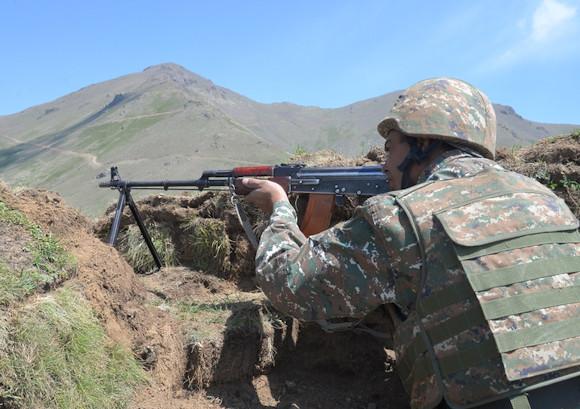In recent days there has been an unusual emphasis, both from newspapers and online news agencies, regarding the latest clashes that have opposed the armed forces of the Republic of Armenia to those of the Republic of Azerbaijan. The interesting news is that, this time, the clashes took place along the internationally recognized state border and not along the "Contact Line" that since 1994 separates the Armenian and Nagornine armed forces on one side and the Azerbaijani ones on the other, inevitably marking an elevation of the clash to a new level.
For beginners, the conflict between Armenians and Azeris has dragged on for several centuries and has changed its connotations according to the political seasons and the entities that have fought over control of the Caucasus, often using the Armenian-Azerbaijani dispute, as a pretext and fig leaf at the same time, to justify their machinations. Whether they were Russians, Turks or Persians, the Caucasus was tempting to all the contenders and the local conflicts had to be exploited for the use and consumption of the hegemon on duty.
The current "hot" phase of the Armenian-Azerbaijani conflict finds main (but not unique) justification in the possession of the territory of Nagorno-Karabakh (Artsakh), a largely mountainous territory, and characterized by breathtaking landscapes, located on the extreme southern reaches of the Caucasus is known to the Turkic populations with the nickname "Black Garden" (because of its dense forests, so different from the boundless steppes characterizing the lands of Central Asia from where the parent hordes of modern Turks came).
The first myth to dispel when talking about Nagorno-Karabakh (Artsakh) is that the aforementioned territory has been invaded by the Armenians and that it is currently "occupied" by the military forces of the Republic of Armenia. This version, officially adopted by the Baku authorities, represents the quintessence of the bad faith of the Azeris and their supporters internationally (alas, the majority).
The population of Nagorno-Karabakh (Artsakh) has always been constituted by Armenians for its absolute majority since the origin of writing and, indeed, this region represents the very heart of the territory of origin of the Armenian people and culture, together with the finite province of Syunik (part of the Republic of Armenia) and the Autonomous Republic of Naxçivan (the latter still part of Azerbaijan and completely "cleaned up" in recent years by the Baku authorities of both its Armenian population and the monuments from it built over time).
In 1988, in the wake of the upheavals that affected the Soviet Union in the Perestroika period and which would shortly lead to the disintegration of the empire, the Nagornian Armenians declared secession from the Soviet Republic of Azerbaijan (from which they had always felt rightly oppressed) and reunification with the Soviet Republic of Armenia. The subsequent "Nagorno-Karabakh War" lasted until 1994 resulting in the collapse of Azerbaijan's military capabilities (which also went through a period of troubled internal politics) and the signing of the "Bishkek Protocol" which, although not recognizing neither independence of Nagorno-Karabakh (Artsakh) nor its reunification with the Republic of Armenia, also sanctioned the joint control of Armenians and Armenians nagornini over much of Nagorno-Karabakh (Artsakh) and the neighboring Azerbaijani territories collectively known as "areas of safety".
Far from turning into an all-inclusive peace treaty, the "Bishkek Protocol" was a simple moment of transition between the "real war" and the "intifada of war". Between 1994 and today, mutual provocations have continued to claim deaths from both sides, as not a single day has gone by without commandos raids, artillery combat, sniping, and aircraft or helicopter attacks while diplomatic action was reduced to a situation of real stalemate.
Since 2008, the provocations have evolved even worse, while the incendiary rhetoric used mainly by Azerbaijan on the domestic front is only increasing hatred towards the enemy.
The worst escalation occurred in April 2016 when Nagorno-Karabakh (Artsakh) was the scene of a new war (the so-called "Four Days War") which claimed at least several hundred deaths (although the secret military and the extensive use of disinformation, especially by the Azerbaijani side, do not allow to fully appreciate the seriousness of the event).

The summer of this year brought yet another resurgence in the clashes, this time however moved north to the border of the Armenian province of Tavush and the Azerbaijani ones of Tovuz, Qazakh and Gadabay. This unfortunate event, in itself tragic, was quickly exploited by the high spheres of Baku, however in this situation the Azeris were unable to "sell" the event internationally as well as when the clashes took place in the area of Nagorno-Karabakh (Artsakh). Nonetheless, a series of very tough positions have been recorded by various national and international institutions at the international level.
Interesting the sentence, which we could define as "multipartisan", by several study centers, generally orbiting the figure of the ex-Foreign Minister Giulio Terzi di Sant'Agata, whose final declarations, however, once read, makes the legitimate suspicion arises that our "experts" are at least poorly accustomed to the analysis of Caucasian balances when not totally ill-informed about the real situation on the ground, such as when they require "The immediate withdrawal of Armenian forces from the disputed area". We should have the grace to explain to them first of all that the current crisis has as its focal point an area far from that of the classic conflict. Secondly, even if we want to speak at all costs of "disputed area", it is good that they know that Nagorno-Karabakh (Artsakh) is not a gigantic "military camp", but a state in all respects inhabited by 150.000-172.000 people. largely "indigenous" and descendants of people who have inhabited that area for thousands of years. The author of the present analysis frankly finds it difficult that all these people agree to leave "with a smile on their lips", especially after, between 1988 and 1994, they fought a bloody and victorious war for their own salvation and self-determination (the which, moreover, is recognized both by the "Bishkek Protocol" and by the subsequent "Principles of Madrid").
Another chapter that deserves to be treated is that of the inevitable civilian victims that mark this type of conflict, given that even on this occasion it seems that there were some from the Azerbaijani side. When questioned in this regard, the Armenian authorities did not deny the incident but at the same time specified that the responsibility for civilian deaths lies with Baku's wicked decision to place his artillery pieces in the middle of the inhabited areas. This statement requires us to pay attention to the different value that the contenders attribute to the life of civilians. While in fact along the whole Armenian side of the front line both the authorities of Yerevan and Stepanakert (nagornina capital) have imposed a "militarized" belt in which, by virtue of the state of war, civilians have no possibility of allocation and residence, on the Azerbaijani side nothing like this has ever been done, indeed, often and willingly trenches, machine-gun nests, artillery positions and bunkers are located right around the inhabited centers so as to use their inhabitants as human shields.
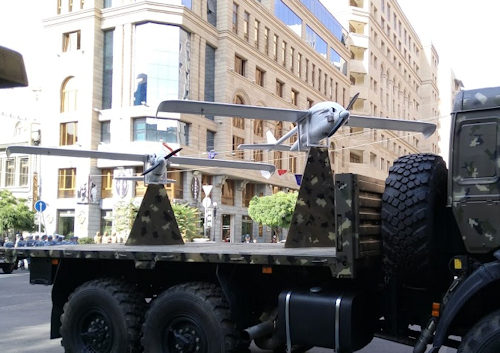 Despite the extensive use by the Armenian forces of UAV, terrestrial detection radars, infrared detection systems and special forces operators operating as reconnaissance to make the counter-battery fire as accurate as possible, collateral damage with consequent civilian losses are inevitable, as has also been seen these days.
Despite the extensive use by the Armenian forces of UAV, terrestrial detection radars, infrared detection systems and special forces operators operating as reconnaissance to make the counter-battery fire as accurate as possible, collateral damage with consequent civilian losses are inevitable, as has also been seen these days.
In general, the exchanges of artillery between the two sides take place in the following way: after hitting Armenian positions even for whole days through the use of rifles and cannons without recoil and mortars of 60 and 82 mm the Azeris can stop or decide to raise the stakes by deploying Turkish-made TR-107 multi-tube field rocket launchers (in turn largely inspired by the Chinese-made PLA 107). This then causes the immediate Armenian counter-battery fire which results in the destruction of the launch positions but which often leads also to the civilian casualties of which we are told. However, to an attentive reader, these events sound absolutely familiar. During the "Four Day War" of April 2016, both Armenians and Azerbaijani complained of a number of civilian casualties. From investigations on the ground by Murad Gazdiev, RT correspondent, while the dead and wounded of Azerbaijan had been hit by Armenian fire when a massive presence of troops was reported in their inhabited centers, on the other hand, the Armenian civilian casualties were all incurred when Azerbaijani fire had hit their homes located miles away from the front line and without the slightest presence of hostile forces justifying sustained artillery fire. Any further comments are superfluous.
On the war front, it is not easy to find certain information relating to the real human and material losses suffered by the contenders, however we can affirm that, while the relative openness and democratization of Armenian society can make us hypothesize that the official Armenian losses substantially correspond to reality, the official ones Azerbaijani are patently false.
The empirical experience of all human conflicts, from the introduction of gunpowder to today, shows that any attacking army is destined to suffer three to five times greater losses than the defending army, as long as it does not have a crushed firepower and better trained and equipped soldiers. In the specific case, Azerbaijan cannot count on either of the two conditions.
 Although Baku has been able to spend enormous amounts of money on modernizing its military instrument for the past twenty years, this has not translated into an irresistible firepower. In fact, being a member of the Collective Security Treaty Organization and having always cultivated good relations with Russia, Armenia was able in turn to strengthen its armed forces by being able to buy modern armaments from its imperial protector at discounted prices or even for free, what is closed to your opponent.
Although Baku has been able to spend enormous amounts of money on modernizing its military instrument for the past twenty years, this has not translated into an irresistible firepower. In fact, being a member of the Collective Security Treaty Organization and having always cultivated good relations with Russia, Armenia was able in turn to strengthen its armed forces by being able to buy modern armaments from its imperial protector at discounted prices or even for free, what is closed to your opponent.
It is difficult to fully evaluate the arsenals of the two contenders, given that the situation of "perennial war" leads both to be somewhat "buttoned" with regard to numbers and organization of their military instruments. However, a quick look at both the defense budgets and the journalistic indiscretions, which speak from time to time of mega contracts entered into by one or the other of the two contenders, can make us glimpse a glimmer of truth even beyond the smoke screen of the military secret and war disinformation.
In light of the foregoing, we can say that, on paper, Baku is in possession of numerically superior military forces and equipped with more numerous armaments although, the numerical difference (which, depending on the type of armament, varies from 1: 2 at 1: 3) is not enough to obtain that superior firepower that would be desirable to resolve the Nagorno-Karabakh dispute "military manu". At the same time, the Azerbaijani armed forces are plagued by a series of inveterate inefficiencies (corruption of the official corps, hazing, lack of training and discipline) that do not allow them to be on the same qualitative level as their Armenian and Nagornine counterparts.
These problems had already emerged in a clear way during the "Nagorno-Karabakh War", between 1988 and 1994. Even then the Azerbaijani military had been defeated and humiliated by an opponent much less numerous and quantitatively less armed but qualitatively better trained and determined to fight a war that the whole Armenian population saw as a "war for their own existential survival". On the other hand, however, the Azeris saw war as nothing more than a repression of a momentary separatist movement. In fact, while during the long years of the war the authorities of Yerevan and Stepanakert worked hard to send as many men (and women) as possible to the front, on the other a good percentage of Azerbaijani males of military age did not disdain to evade the lever mandatory preferring the comforts of the Baku seafront to the cold and hunger of the mountains and forests of Nagorno-Karabakh. One of the measures taken by the government to stem the bleeding of denials was the massive conscription of personnel from the country's ethnic minorities (especially Russians, Lezgini, Avari and Talysh, but not only) demographically unable to rebel against the diktats of central power.
 By way of example, we can mention the fact that the most important and celebrated "Azerbaijan National Hero" of the Nagorno-Karabakh war, the late Albert Agarunovich Agarunov (photo) was not an "Azerbaijani in the strict sense" but a so-called "Jew" in the mountains ”(the Mountain Jews are a very ancient Jewish community in the Caucasus that have always been famous for their exceptional warlike skills), and who apparently complained before dying aboard his tank during the battle of Shusha in 1992 several times with journalists who, for the most part, were minority soldiers who had to take on the burden of war.
By way of example, we can mention the fact that the most important and celebrated "Azerbaijan National Hero" of the Nagorno-Karabakh war, the late Albert Agarunovich Agarunov (photo) was not an "Azerbaijani in the strict sense" but a so-called "Jew" in the mountains ”(the Mountain Jews are a very ancient Jewish community in the Caucasus that have always been famous for their exceptional warlike skills), and who apparently complained before dying aboard his tank during the battle of Shusha in 1992 several times with journalists who, for the most part, were minority soldiers who had to take on the burden of war.
Another was the widespread use of foreign volunteers and mercenaries including thousands of Turks, Chechens, and even Afghan mujahideen. It is interesting to note that this practice is not disdained even today, given that, after the military confrontation of 1-5 April 2016, the Armenian authorities spread the news of how, on several occasions, their forces on the ground had recovered from the corpses of the enemies killed in battle documents and currency attesting the foreign origin of the aforementioned armies.
As icing on the cake we can then mention the reports drawn up jointly by the two intelligence agencies of Armenia, the National Security Service and the Intelligence Department of the Armed Forces, in which it was expressly stated that elements of al-Qaeda and fighters of the ISIS were fighting alongside Baku's forces. The existence of these confidential reports was publicly revealed by Kaylar Michaelian, permanent representative of Nagorno-Karabakh in Australia and subsequently relaunched by the Syrian news agencies SANA and Al-Masdar News.
It is fair to mention the fact that Syrian President Assad had expressly cited Azerbaijan as one of the "labor-supplying" countries for ISIS one month before the Paris Bataclan attacks and that a few weeks before the outbreak of the war in Nagorno- Karabakh in 2016 the same Syrian secret services, together with the Russian ones, had warned that the Turkish secret services were favoring the exfiltration of about sixty Azerbaijani ISIS terrorists probably to bring them back to the Caucasus area . The most widespread opinion at the time was that these operatives were directed, together with other elements of Chechen or Caucasian ethnicity, to target Russian targets located in Georgia, South Ossetia, Abkhazia or even in the Russian Caucasus itself, where the black flags of ISIS have started to wave in place of the traditional Chechen resistance. The fact that they were hijacked at the last moment in Azerbaijan demonstrates three fundamental things:
- the degree of strategic imagination and improvisation with which the Turkish secret services are equipped;
- the high degree of collaboration and "synergy" now reached between Ankara and Baku;
- the fact that, in addition to being a terrorist organization that developed into an authentic "mafia organization", ISIS (now deeply infiltrated and hetero-directed by the secret services of Turkey, Pakistan and Saudi Arabia) has also become an authentic "gang of mercenaries "that can supply for this purpose contingents of more or less numerous fighters and absolutely expendable to this or that power for a ready use in the most disparate theaters of the" Third World War in Pieces "denounced by Pope Francis.
 But Erdoğan, Aliyev and their associates did not stop there. On July 18, Sham FM, Syrian radio outlet, again citing the secret services of Damascus announced that, after having appeared in Libya and Yemen, now the Syrian jihadists belonging to the various Islamist factions caged in the province of Idlib and in the areas below Turkish occupation is now also being deployed to serve Turkish interests in the conflict between Armenia and Azerbaijan. Sham FM even took the example of a 300-man unit recruited from members of Hay'at Tahrir al-Sham, the ex-Jabhat al-Nusra, who would sign the terms for an "operational tour" in the Caucasian area lasting six months receiving a salary of $ 2.500 monthly.
But Erdoğan, Aliyev and their associates did not stop there. On July 18, Sham FM, Syrian radio outlet, again citing the secret services of Damascus announced that, after having appeared in Libya and Yemen, now the Syrian jihadists belonging to the various Islamist factions caged in the province of Idlib and in the areas below Turkish occupation is now also being deployed to serve Turkish interests in the conflict between Armenia and Azerbaijan. Sham FM even took the example of a 300-man unit recruited from members of Hay'at Tahrir al-Sham, the ex-Jabhat al-Nusra, who would sign the terms for an "operational tour" in the Caucasian area lasting six months receiving a salary of $ 2.500 monthly.
The overall scenario that is outlined, therefore, is not that of the accident but of the real premeditation; but by whom? Accepting as very probable the "premeditation" of the Azerbaijani invasion, it remains to be seen who between Erdoğan and Aliyev was the real engine and architect of the "king's gambit".
Let's be clear: Aliyev would never have embarked on such an adventure without Erdogan's full support. Thinking about it, there were (and there are) numerous internal reasons for pushing the Azerbaijani autocrat towards a rekindling of the conflict (diversion of public attention from internal problems, reduction of internal opposition to silence by leveraging on patriotic sentiment, disguise the catastrophic management of the Covid-19 crisis, etc ...).
Another element that should not be underestimated is the ongoing oil price crisis which has a very negative impact on Baku's budget and pushes the dictator Ilham Aliyev to use the endless conflict as a relief valve to direct internal discontent towards the hated Armenians. However, even considering these situations, Erdogan is the one who has the most to gain from setting fire to the Caucasus. In fact, with this move the sultan obtained the following results:
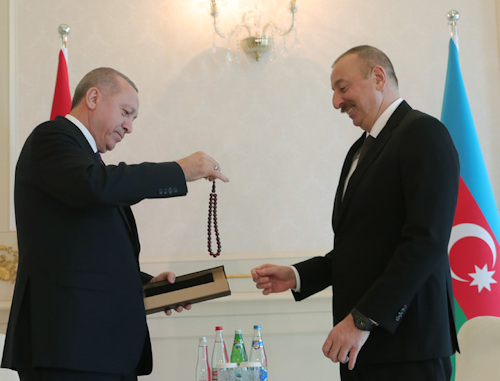
- counterattacked the strengthening of the Russian presence in Syria;
-has demonstrated that he is able to create a potentially dangerous crisis close to Russia's borders;
-has partially discredited Russia's prestige towards all other ex-Soviet states;
- pushed Azerbaijan even further into the arms of Turkey;
-has shown that he is pursuing a foreign policy that can be independent of Washington's "wishes";
- internationalized the Armenian-Azerbaijani conflict and the open clash between Turkey and Russia;
- winked at Kiev, always looking for anti-Russian allies;
-has sent a message to his Saudi and Pakistani "allies" (follow me to the end!);
-has sent another message to Europeans and Iranians (I'm a dangerous man!);
- tried to corner Yerevan, as he has already tried many times.
I will not now go into a detailed analysis of each of the points announced above nor will I evaluate their impact in the short, medium and long term. I will limit myself to saying that, among the ten points outlined above, one of them, the last, constitutes a huge error of assessment.
If from the height of his power the Turkish sultan can think he has tightened little Armenia within a ring of kelp, leaving the inhabitants of that country faced with the only choice to submit or perish, he demonstrates, in perfect style Turkish, not having understood in the slightest that for the Armenians, it does not matter whether Armenia, Nagorno-Karabakh or the diaspora, this does not constitute a struggle for power but a real struggle for survival.
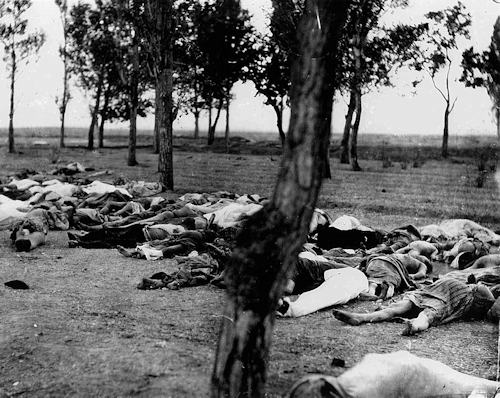 In the absence of an open admission of guilt and repentance regarding the question of Armenian Genocide (photo), Turkey will always be perceived by Armenians around the world as an evil entity that cannot be trusted at all and the inflamed rhetoric of both Erdogan and Aliyev certainly does not help mutual understanding.
In the absence of an open admission of guilt and repentance regarding the question of Armenian Genocide (photo), Turkey will always be perceived by Armenians around the world as an evil entity that cannot be trusted at all and the inflamed rhetoric of both Erdogan and Aliyev certainly does not help mutual understanding.
On the other hand, albeit smaller, poor and characterized by the same contradictions present in all the former Soviet societies, Armenia has already started for years a slow but progressive process of internal transformation following the example of that implemented by Israel over the years 50s and 60s of the last century. Furthermore, although corruption and nepotism are prevailing, Armenian society is incomparably more democratic than Azerbaijani society, political elections are fought and participated, ethnoreligious minorities are recognized and protected (and not subjected to a work of progressive assimilation and "extinction" as happens in Azerbaijan and, even worse, in Turkey) and the people in general are supporting actors and not mere "executors" of the elite orders, especially after the events of the so-called "Velvet Revolution" of 2018 that brought to power Nikol Pashinyan.
Do not underestimate the role of the powerful Armenian Church and the Diaspora both as "power multipliers" and "influencing agents" on the foreign front and as "democratizing elements" and "innovation vectors" on the domestic front. Taking all this into account, it can be clearly understood how, in the long run, the "defensive strategy" carried out by Yerevan and Stepanakert has a better chance of being successful while the failure of Baku's "offensive strategy" will inevitably lead to the internal contradictions of the regime surfaced just as they did at the end of the first "Nagorno-Karabakh War" (1988-1994). Before such an outcome is reached, however, it would be strongly advised that the international community take note of how, with each new provocation and each new victim along the "Contact Line", the current status quo in Nagorno-Karabakh is absolutely unsustainable.
The field actions of the Turkish leader, since he took power in 2003 until today, constitute a tangible demonstration that that man is dangerous for world peace and will never stop until his goals are fully achieved: the restoration of Turkey to great planetary power on the ashes of the Middle East, North Africa and Europe and his personal "enthronement" as the greatest Turkish in history ".
In this extremely dangerous game, the small but resolute Armenia represents (just like Assad's Syria, Iraq and Libya) both a symbolic and physical obstacle that the sultan wants to destroy or subdue because in his solipsism no one can afford to say " no "and, for those who do, there can only be rubble and mourning.
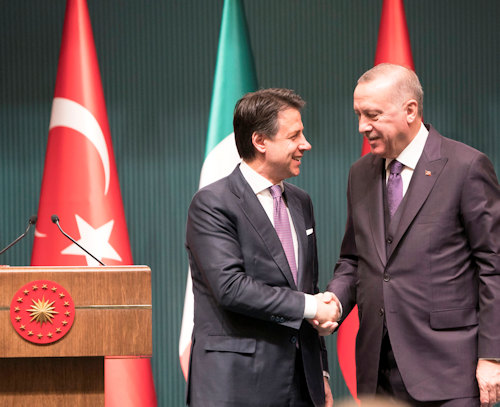 Instead of signing improbable "humanitarian agreements" or "strategic partnerships", European leaders should instead finally understand that Turkey's actions contribute neither to peace nor to global stability and that, on the contrary, in the Caucasian area they are precisely the demands of the Armenia and Russia those who have stability and balance most at heart.
Instead of signing improbable "humanitarian agreements" or "strategic partnerships", European leaders should instead finally understand that Turkey's actions contribute neither to peace nor to global stability and that, on the contrary, in the Caucasian area they are precisely the demands of the Armenia and Russia those who have stability and balance most at heart.
The heads of state and government in Europe and throughout the free world are called to recognize this reality otherwise the Turkish provocations will become more and more dangerous and uncontrollable and, in twenty years, the survivors of the Armenian New Genocide and the " Third World War in Pieces "will see the birth of a" New Ottoman Gold Era ".
In conclusion, whether we like it or not, we are witnessing a resurgence of the never dormant conflict over the domination of the southern Caucasus. The signs of this escalation should have already mobilized the international community about fifteen years ago, but the short-sightedness of the political decision-makers and the general disinterest (when not the conscious ruthlessness) have meant that the situation continues to degenerate until what always appears more as a point of no return, especially now that in the Caucasian game the Turkish president-master Recep Tayyip Erdoğan decided to enter as titular player, firmly intending to claim even in those lands a space of geopolitical expansion for Turkey.
Photo: Republic of Armenia MoD / Sonashen / President.az / Jonj7490 / Mangust777 / web / presidency of the Reupublic of Turkey / presidency of the council of ministers

